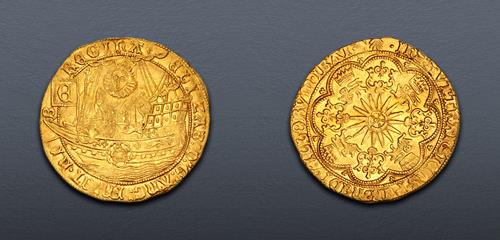|
TUDOR. Elizabeth I. 1558-1603. AV Ship Ryal (34mm, 7.49 g, 1h). Dutch imitation struck in Amsterdam(?), circa 1585-1587. ЄLIZAB’· D’· G’· ΛnG’· FR’· ЄT · hI B RЄGINA (trefoil), half-length figure, wearing ruff, facing, holding scetpter in right hand and globus cruciger in left, on ship left with Є on banner at prow / (escallop) · IhS’· ΛVT’· TRΛnSIЄnS’· PЄR’· mЄDIV’· ILLORVm · IBΛT ·, radiant sun, with rose in center, over floreate cross with lis at ends; in each quarter, crown above lion passant left; all within tressure of eight arches with trefoils in spandrels. Thompson, Elizabethan – (dies O7/R– [unlisted rev. die]); Schneider 890 (same obv. die); Delmonte –; North 2004 note; SCBC 2530 note. In NGC encapsulation 6485724-001, graded MS 61. . Sharply struck with residual luster. A choice example of this very rare issue.
Ex Baldwin’s of St. James’s 14 (14 January 2018), lot 68; Roderick Richardson FPL Summer 2002, no. 9; Spink 81 (19 November 1990), lot 34 ‘Extremely fine and very rare.’.
In late 1585 Elizabeth I, recognising the growing threat to the Protestant cause in Europe, sent an English force of 5000 foot and 1000 horse to the Low Countries in support of the United Provinces in their revolt against the rule of Philip II of Spain. The queen’s favourite and one time suitor Robert Dudley, Earl of Leicester was given command of the army. Studies by H. Allen and subsequently J. D. A. Thompson have shown that much of the large treasure taken by Leicester to fund the expedition was, in large part, was comprised of gold Sovereigns and Ryals. The Ryal, a denomination first issued for Elizabeth in 1584, may indeed have been specifically struck with the Dutch campaign in mind. Since it was introduced by Edward IV of England in 1464 the gold Ryal, or Rose Noble, of 120 grains had been a very popular denomination in the Low Countries. The Elizabethan Ryal elaborated on the design of its late medieval predecessor by depicting the queen wearing a ruff and ornately jewelled dress aboard an accurately rendered late sixteenth century frigate.
The introduction of the Elizabethan Ryals to the circulating medium of the Low Countries apparently resulted in a much smaller contemporaneous local issue of the type. Thompson ventured they may have been struck in Amsterdam. The Dutch Ryals are very close copies of the English prototype and bear the same mint marks - A and escallop - which were in use for the duration of the English army’s presence in the Low Countries. While these Dutch Ship Ryals may have been the product of a local mint seeking to profit from the confused state of the currency at this time, numismatists have also speculated that they could, in Thompson’s words, be ‘an official copy of the English coinage for Leicester’s government’. We know that Leicester was in constant need of coin, was involved in re-organising and re-tariffing the existing coinage of the United Provinces and even proposed a special coinage of Ryals to pay his army and bring profit to the English Crown.
The final winners of all Triton XXVI lots will be determined at the live public sale that will be held on 10-11 January 2023.
Triton XXVI – Session Four – Lots 991-1315 will be held Wednesday afternoon, 11 January 2023 beginning at 2:00 PM ET.
Winning bids are subject to a 22.5% buyer's fee for bids placed on this website and 25% for all others.
We recognize that our users may have various Internet Browsers and Operating Systems. We like our visitors to have the best possible experience when using our bidding platform. However, we do recognize that it is impossible to develop applications that work identically, efficiently and effectively on all web browsers. The CNG bidding platform supports the latest stable major version and stable previous version of Chrome and Firefox.
|
